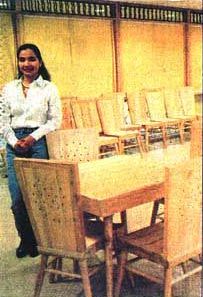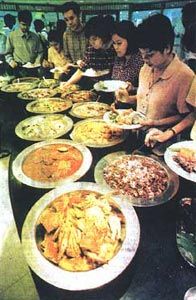A '50s Inspired Cabalen Opens At Robinsons Place
Philippine Star Sunday Life Section
November 30, 1997, pages L-1 to L-3
Architecture and interiors by Melinda P. Laudico
A 50s-inspired restaurant in a Nineties' shopping mall?
Hmmm. Such a cool idea can only come from someone like young and innovative restaurateur Maritel Nievera who keeps the dining public guessing what she's cooking up next.
Of course, we're talking about Maritel Nievera's new Cabalen Restaurant in Robinsons Place Manila, which has been the talk of the town since it opened last week.
Maritel, the beauty-and the brains-behind the successful Cabalen chain of restaurants, commissioned young and vibrant architect Melinda Minerva "Popi" Laudico to design the new Cabalen as a modern food haven perked up by the piquant flavor of the Fifties.
Why the Fifties? "Why not?" Popi counters. "The Fifties were the golden era of Manila, it was the time when Ermita was at its peak. When life was gentle and genteel."
Only 27, Popi feels she has lived in the '50s. "I grew up in the '50s house of my grandparents on Shaw, Mandaluyong," she waxes nostalgic. "I lived there until I was 12. I remember the grillwork on the walls and the granulitic floors."
Popi Laudico has been drawing houses since she was in Grade III. With a little push from her mom who raised her amid a very creative environment, Popi decided to take up architecture. She knew it was her line-her lifeline, to put it pat. Today, Popi looks up to such towering figures in the world of design as Frank Lloyd Wright who designed the Guggenheim Museum in New York and Norman Foster who did the almost perfectly feng-shuied Hong Kong Shanghai Bank in Hong Kong. She has no local idols only because there's not much literature you can read about local architects.
"I tend to idolize not so much the end product as what goes into its building," Popi beams. "This is my first high-end project. I'd done houses, office buildings and shops. I'd done fast-food outlets like Jollibee inside Makro in Cainta. Doing fast-foods is pretty cut and dried. What I enjoyed was that they let me do the mural. Now I'm doing the house of the owners of Jollibee and a store cum café in Glorietta."
Little did these creative soulmates - Maritel and Popi - dream that their paths would cross one day. Maritel herself was an interior designer before she turned to the fine art of cooking and put up her own restaurants. "I met Maritel through my mother," say Popi.
Popi's mother, Yolanda Perez Laudico runs the Soumak collections which is in the business of exporting high-end custom made home and office furniture, some of which have found their way into the homes of Hollywood celebrities.
Popi adds: "Maritel was looking for furniture for her house. No, she was not building a new restaurant at the time. She would come to my mom's office and would see me work, pa konti-konti. Most of the things in our shop you can't find anywhere else because I and my mom design them."
When Maritel and Popi sat down to discuss plans for the new Cabalen restaurant, Maritel told Popi she wanted a restaurant that people can easily identify with Cabalen, and yet distinct enough to separate it from the three other Cabalen restaurants, each one of which is a success in its own right: Cabalen West Avenue, Cabalen in SM Megamall on Ortigas and Cabalen in Glorietta, Ayala Center, Makati.
Says Popi: "You will notice that all Cabalen restaurants look alike, as if they were fashioned out of the same mold. They all exude feeling of a period in the history of the Philippines. For instance, Cabalen in SM Megamall depicts the Bahay ng Gobernador as designed by Pampanga-based artist Claude Tayag. The place echoes that time in Philippine history, from the furniture to the floor tiles that seem to have leaped out of the 30s. On the other hand, the Cabalen in Glorietta, Makati designed by young architect Reimon Gutierrez, has a modern Filipino ambiance. Maritel herself designed her first restaurant on West Avenue in Quezon City, which is her only stand-alone restaurant. So Maritel and I were saying that since this Cabalen is in Malate, Manila, why don't we take a period from Manila's history when it was booming?"
Popi fondly pictures the nifty Fifties: "By then, people were becoming modernized already. But they did not want to let go of the old elements. They embellished their homes with grillwork that was round, somewhat geometric. The grillwork I grew up with in my Lola's house is the same thing you'll see in the new Cabalen. Probably the only characteristic of the '50s we had a hard time duplicating here was the wood paneling. So you see, we did not just copy from the '50s; it had to be functional, too. After all, we were building a restaurant, not a house."
For the sake of authenticity, Popi asked her lola to share with her some tattered notes from the cherished era of the '50s. She showed me her old pictures as well as her old, dog-eared magazines," Popi relates. "There's more documentation on the '20s, '30s, '60s and '70s than on the '50s. Not much was preserved of that somewhat ambiguous period unlike perhaps the '20s to the '70s, which were defined. The '50s marked a kind of transition."
When you enter the new 130 to 140-seat Cabalen restaurant in Robinsons Place Manila, you get that glorious Fifties feeling. You walk on floor made of, hold your breath now Murano tiles-yes the same Italian source that produces Murano crystals. What catches the eye next is the impeccably riveting food counter made of black granite where you see stainless steel bowls resting on native nito rings.
"The bowls were designed and made by Popi's mother, Yola Perez," says Maritel. "They are surgical stainless and made especially for Cabalen. In the same way that our bowls in Cabalen, Glorietta were especially made by Lanelle Abueva from Pinatubo ceramic."
And the non-stop feasting continues as your eyes turn to the colorful mural by young UP artist Jet Melencio behind the buffet table. "Abstract art was in full bloom in the '50s," says Jet Melencio. "Abstraction was a mode of expression in the art of the '50s. In period dining rooms, there were plate collections with abstract designs."
For the new Cabalen in Robinsons Place Manila, Jet is dishing up 11 individually designed plates, mostly in the shades of orange. "It's a usual Pinoy practice to display plates inside glass cabinets in the dining area," Jet points out. "These plates are just for display and are hardly used. Now we're using the plates as part of an artwork."
It was Jet, along with two other artists, who did the 70-foot mural in the lobby of Evercrest in Batulao. Like Popi, Jet is a disciple of the minimalist, spare look.
No need to hang anything on the walls because they're made of glass. "We thought that old photos would just gather dust," says Popi. "So we opted for glass walls."
Now comes the most important part-the heart (or should we say the belly?) of the restaurant, "I was very particular, scrupulously exact when I designed the kitchen," says Popi. "Before I did it, I interviewed the entire kitchen staff, from the head cook to the one who chops. It's Maritel's smallest but she says it's her best planned kitchen so far. The flooring is made of non-skid ceramic tiles. It's very compact which is what a kitchen should be. At any one time, eight cooks can cook. Remember, everything is cooked fresh in this restaurant. Everything one needs is just an arm's reach away. Which makes the flow of traffic and time management efficient, resulting in less accidents."
The '50s-inspired wooden chairs and tables tastefully blend with the ambiance of the place. With the new Cabalen, Maritel aims to hit the A, B, C markets. "Everybody's welcome," she says with a smile.
It's certainly welcome news that the new Cabalen is offering the same old Cabalen favorites that Pinoy diners have queued up for over the years. For starters, to tickle the taste buds is the array of salads like burong mustasa salad, labanos salad, fermented rice with shrimp salad, mango and repolyo salad, ensaladang talbos ng kamote and ensaladang talong. Then you start picking up steam on side dishes like ginataang kuhol, crablets, pork kilawin Capampangan, and chicharon Guagua. With your taste buds now at full throttle, you move on to the main offerings: asadong dila ng baka, kalderetang baka, tapang kalabaw, kare-kare, bopis, Cabalen morcon stuffed with pork and beans, chicken hamonado, adobong wild duck, adobong snipes, inihaw na hito with fermented rice, inihaw na gindara, rellenong bangus, tiyang ng bangus steak, ginataang alimango and aligue sugpo, among many others. You cap your affair with good old fashioned Pampango home cooking by giving in to sweet temptations like ginataang halo-halo, halayang ube, tibok-tibok kalamay and buko pandan salad. "Oh yes, we're offering in the new Cabalen our eat-all-you-can buffet for the same price of P198," says Maritel.
As if you hadn't had enough, there are goodies for taking home at the Pinoy Deli, a staple of Cabalen restaurants that carries a hearty mix of Pampango goodies from Cabalen taba ng talangka to sugar cane vinegar to pastries and sweets and Cabalen native chocolate.
Surely, the Fifties never tasted this good!
Featured Project:







